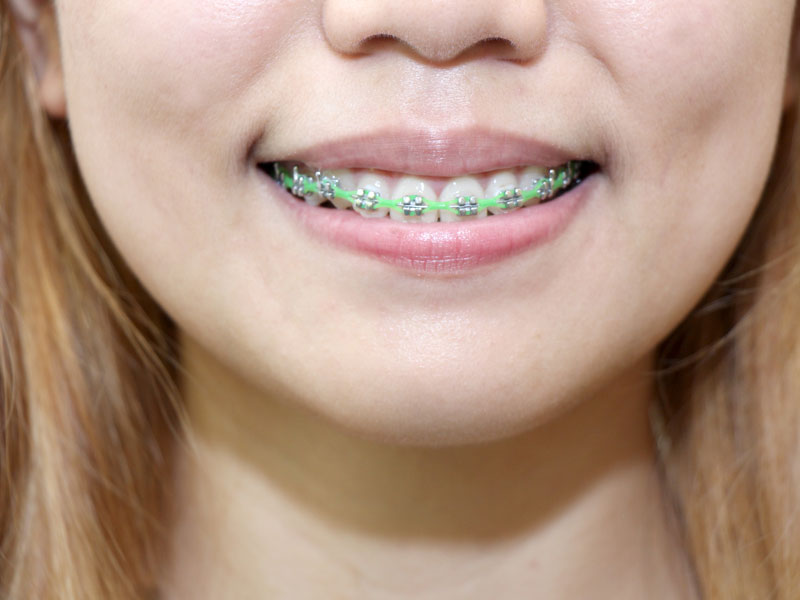How to Maintain a Healthy Mouth While Wearing Braces

Brushing your teeth while wearing braces may seem like an impossible task, especially with traditional metal or ceramic braces. The brackets and the wires make it impossible to even get near the parts of the teeth that aren’t covered by a bracket.
Many people will eventually just give up trying to get their teeth clean, but this can lead to very serious consequences before and after the braces are removed. Learning the proper technique and tools to use, no matter what kind of braces you have, will make keeping your teeth clean and healthy throughout the duration of your treatment easy.
Traditional Braces
The Tools: The first tool you will need is a standard tooth brush. There are toothbrushes made today that have long bristles on the sides and shorter bristles in the center. While these are designed to make brushing the bite surface of teeth easier, they can also be helpful when attempting to brush around brackets.
The second tool you will need is a small, spindle brush. Most orthodontists give these out to their patients after their braces have been applied, but they can also be found in most grocery stores. The third and last tool that you will need is floss. Flossing is one of the most difficult parts of an oral cleaning routine to maintain, but it can be made easier by purchasing a bag of those individual floss picks.
The Method: Before starting to brush, vigorously rinse your mouth with warm water. This will help to dislodge any food particles that might be clinging to the brackets or wire. Spit and repeat if you can still feel some pieces of food hanging on.
Then, just as you would if you did not have braces, put toothpaste on the brush and begin brushing around the brackets. Most people will just swipe the toothbrush along the surface of the brackets, without really making any effort to brush the teeth themselves. While cleaning the brackets is important, it is also important to make sure that the entire tooth is also cleansed. Make sure to brush the insides and the bite surface of your teeth.
Once you are finished with the regular toothbrush, get out your spindly brush and thoroughly clean the spaces between the brackets and the wires. Last, but not least, use a piece of floss or a floss pick to clean in between each tooth thoroughly. In between teeth is where bacteria is most likely to hide and fester, so be sure to thoroughly floss each area.
Lingual Braces
Lingual braces have the benefit of being nearly invisible when you open your mouth. They are, however, often harder to clean than regular braces, as they are on the insides of the bite, and are more difficult to see. Many of the tools and techniques are the same for cleaning lingual braces, but there are some notable differences.
The Tools: A toothbrush, spindle toothbrush, and floss are all still necessary. Cleaning the outside and in between spaces of your teeth will be much easier when you have lingual braces, but keeping the backs of your teeth clean can become a challenge.
The Method: It may seem that food is more likely to get stuck in lingual braces than in traditional braces, because they are inside the bite, where most of the food is being processed by the teeth. This may mean that they have a collection of food pieces and particles. Start with a thorough rinse. Using a warm, saltwater rinse can help to reduce an inflammation or irritation that you might experience in the first few weeks of wearing braces.
After the rinse, start by cleaning the outsides and bite surfaces of your teeth. This will be the easiest part of your cleaning routine. Then, using the brush at an angle, clean the inside surface of your teeth and the tops of the brackets. Angle the brush in the other direction to clean the tooth under each bracket. Then, it’s time to break out the spindle brush and carefully clean along the sides of the brackets and under the wire.
Then, floss. Flossing may be easier with lingual braces than with traditional braces, but a floss pic is still recommended. Topping off any tooth brushing routine, either for traditional or lingual braces, with a fluoride-rich mouthwash is always a good idea.
Invisalign
Invisalign aligners seem like they should be easy to clean and make it much easier for you to keep your mouth clean, but many people do not realize that the close proximity of the retainers to the teeth can actually hold bacteria against the enamel and create a mouth environment that is very conducive to the development of cavities. Keeping your aligners and teeth clean through the process is very important.
The Tools: A standard toothbrush will usually do the trick. Some people do prefer a toothbrush with softer bristles to address the aligner itself. Floss and mouthwash should also be used.
The Method: After eating (or before putting in the aligners at any time), thoroughly brush and floss your teeth. Make sure there are not any food particles hiding in between teeth or on the bite surface, where cavities are most likely to develop. Then, rinse your aligners in clean water and put them in.
To clean your aligners, try a denture cleaner or other product that can be dissolved in warm water, in which you then soak your aligners. This will keep them clean and fresh. In between soakings, brush them with a clean, wet brush—but be careful not to use toothpaste, as this will discolor the trays.


Leave a Reply
You must be logged in to post a comment.